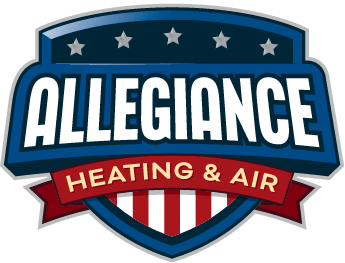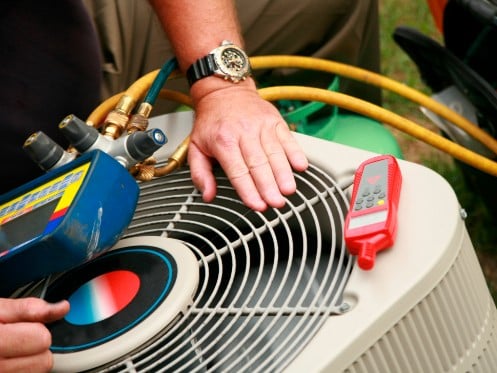When the time comes to buy a new HVAC system for your home, choosing the right system size is critical. If you choose an HVAC system that’s too small, it will struggle to heat and cool your home. If you choose one that’s too large, it will suffer unnecessary wear and tear and won’t operate efficiently. This is a big reason why you’d want to work with a trustworthy HVAC company like Allegiance Heating & Air, LLC to help you. However, we love informed customers. So, here’s some information you can use to determine the proper HVAC system size for your home. We’ll even let you know a little bit about the way our professional HVAC technicians would determine the proper system size for your home. Let’s dive in.
Understanding Residential Load Calculations
The first thing you’ll need to know to understand how residential HVAC sizing works is a concept called residential load. This refers to a top-to-bottom calculation representing how much heating or cooling a given home needs to stay within a reasonable temperature range year-round. Calculating a residential load requires thinking about everything from where your home’s located and which direction it faces to your insulation and the number and types of appliances you own. Unfortunately, a true residential load calculation isn’t something a homeowner can do themselves. It requires quite a bit of HVAC knowledge and experience. That’s what Allegiance Heating & Air, LLC brings to the table. But there are a few ways you can arrive at a reasonable HVAC size estimate yourself.
Reasonable Heating and Cooling Need Estimates
To come up with a reasonable idea of how much heating and cooling capacity your home requires, you can use a few simple rules of thumb. They will help you create a base load estimate for your home. This is an estimate that uses average heating and cooling requirement data and doesn’t take the specifics of your home into account. While it won’t yield an estimate you can use for your final installation, it should be precise enough for you to begin shopping for an HVAC system that’s around the size you’ll eventually need.
To determine what size furnace your home will need, you’ll need to know two things. The first is that Greenville, IN, is a part of climate zone 5. This means we generally have cold winters, and homes here require greater heating capacity than you’d need elsewhere in the US. This translates into needing between 50 and 60 BTUs per square foot to keep your home comfortable in the winter. So, all you need to do is multiply that by the number of square feet in your home, and you’ll arrive at a reasonable estimate for your furnace size.
To figure out what size AC your home needs, the process is similar. The main difference is that summers here aren’t as hot as they might be elsewhere, so you won’t need as much cooling capacity. In our climate zone, homes require between 35 and 40 BTUs of cooling capacity to remain comfortable in the summer. So, multiply that by your home’s square footage to arrive at an AC size estimate.
In both cases, you should have noticed that the heating and cooling figures you used for your calculations aren’t precise. For best results, you should err on the high side of the given rages. This is because it’s always better to have slightly too much heating and cooling capacity than too little.
Understanding the Manual J Calculation
If you want a precise HVAC size estimate, you’ll need a qualified HVAC professional to do something called a Manual J calculation. Manual J is a guide produced by the Air Conditioning Contractors of America (ACCA) that includes detailed heat load information for every facet of a home and a formula to arrive at a precise residential load figure.
To perform a Manual J calculation, an HVAC professional would start by calculating your home’s square footage. They’d add up the square footage of each room in your home, and subtract any spaces that won’t need heating or cooling. Such spaces may include garages or unfinished attics and basements. They’ll also account for things like rooms with high ceilings, which can add additional heating and cooling load to your home.
Then, they’d inspect all of the insulation in your home. They’d examine what type of insulation you have in all of your floors, walls, and ceilings to figure out their R values. This will help them determine how much heat loss your home might experience in the winter and how much external heat might enter your home in the summer. They’d also check out your home’s windows and exterior doors to determine their energy efficiency and whether they’re reasonably airtight.
Next, they’d ask you some questions to determine how you use your home. They’ll want to know how many people, on average, typically occupy your home. They’ll also catalog your home’s heat-producing appliances, such as ovens, refrigerators, clothes dryers, and standalone freezers. Each will add a specific heat load value to your calculation based on a thorough appliance listing contained in Manual J.
Finally, the HVAC professional would plug all of the values they collected into the formula spelled out in Manual J. That will yield a precise residential load for your home’s specific conditions. However, the process still wouldn’t be complete. This is because the size, design, and condition of your home’s ductwork also play a role in its HVAC size requirements.
If your ductwork isn’t sized correctly, even a properly-sized HVAC won’t perform as you expect. The same logic applies if your ductwork has leaks or obstructions that affect its performance. In those cases, the HVAC professional would recommend the necessary changes or repairs for your ductwork before they’ll complete their load calculation for you. This is to prevent damage to your new HVAC system, as well as to ensure that your home gets all of the comfort that it should from the new equipment.
Your HVAC Sizing Experts
For over 15 years, Allegiance Heating & Air, LLC has served the HVAC needs of homeowners and business owners in and around Greenville. We’re a family-owned and operated HVAC company that works hard to make sure every customer receives quality service and fair prices at all times. We offer comprehensive HVAC services, including installation, maintenance, and repair. That includes working on all makes and models of residential and commercial HVAC systems. We also provide indoor air quality services, as well. Plus, we offer financing on approved credit to help you afford the HVAC systems you need. And we also consider it a point of pride to give back to our community. That’s why we started Project ACE. Through it, we give away complete HVAC systems to local veterans several times per year. It’s just our way of giving back to local heroes that gave so much to ensure our freedom.
So, if you need a new HVAC system and need us to help you with sizing and installation for your home in Greenville, call the experts at Allegiance Heating & Air, LLC today!




